Atomic Energy Commission robot inspired offshore petroleum industry’s remotely operated vehicles.
Shell Oil and Hughes Aircraft companies in 1960 began modifying an advanced but landlocked “Manipulator Operated Robot” — known as MOBOT — into one that could operate underwater. The result would lead to revolutionary offshore swimming machines for petroleum exploration and production.
Much of the 21st century’s offshore oil and natural gas industry relies on remotely operated vehicles (ROVs) that can trace their roots back to Howard Hughes, Jr. In the late 1950s, Hughes Aircraft Company developed its Manipulator Operated Robot – MOBOT – for the Atomic Energy Commission.
Working on land, the robot performed tasks in environments too radioactive for humans. Weighing 4,500 pounds with hydraulically powered steel claws and television eyes, MOBOT was linked by a 200-foot cable to the operator, who used pistol grips and levers to control it.

“Manipulator operated robots” were built for the Atomic Energy Commission to work in a radioactive environment. Photo courtesy September 1960 Popular Mechanics article, “Marvelous Mobot Will Do Work Too Hot For Man.”
In 1960, Popular Science magazine described the advanced technology in “Marvelous Mobot Will Do Work Too Hot For Man.” The article reflected the era’s fascination with science fiction and new technologies.
“With electronic nerves, hydraulic muscles, and TV eyes, a robot whose arms are quite capable of playing golf or snuggling a blonde is ready to live far more dangerously than that,” proclaimed the article’s first paragraph.
An accompanying photo showed the “murderous impulse” of a wheeled Mobot apparently stalking a scientist. But as the caption explained, “Never fear, he (the scientist) has it all under control” by watching three remote camera screens.
America’s offshore oil industry recognized the potential of these “underwater electronic nerves, hydraulic muscles, and TV eyes.”
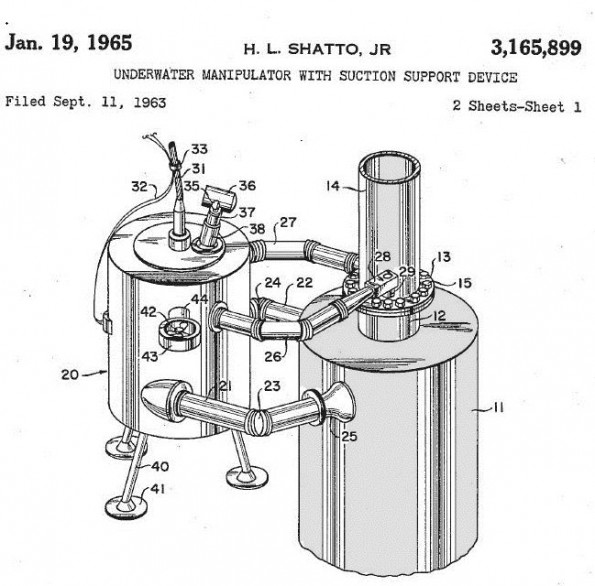
Howard L. Shatto Jr. received a 1965 patent for an “underwater manipulator with suction support device.” He will help make Shell Oil an early leader in offshore oilfield development.
As the search for oil reached deeper into the ocean’s depths, traditional hard hat diving technology advanced to keep up. The advent of saturation diving and helium/oxygen mixtures extended depths and diving times.
Deep Wells Offshore
Saturation diving technologies helped reduce the dangers of decompression sickness — “the bends,” but there were limits to what divers could accomplish in increasingly hazardous depths (learn more in Deep Sea Roughnecks).
Shell Oil Company took the lead in transforming Hughes’ MOBOT into what would one day become known as ROVs. Beginning in 1960, a series of patents described, “a remotely controlled manipulator device for carrying out operations underwater at an assembly position at the top of a well.”
Patents by Howard Shatto Jr. — named to the Oilfield Energy Center’s Industry Pioneers Hall of Fame in 2000 — and others made Shell Oil Company the early leader in offshore development. Shatto explained how an underwater device patented in January 1965 particularly related to the offshore petroleum industry:
“A recent development at offshore locations is the installation of a large amount of underwater equipment used in producing oil fields and gas fields situated many miles from shore,” Shatto noted.
“Many of the wells are being drilled in water up to 600 feet deep, a depth greater than divers can safely work,” he added.

Howard L. Shatto Jr. (1924-2018) became known as “the father of dynamic positioning,” according to the Marine Technology Society.
The inventor added that a primary objective of his design is to provide a “manipulator device” with articulated arms that can secure itself to a wellhead on the ocean floor. “Each of the arms is provided at its outer end with a suitable suction means in the form of a suction cup,” he explained.
Swimming Socket Wrench
Shatto led in the designing of the first subsea wellheads using an ROV, noted the Oilfield Energy Center in 2000. He also conceived automatic controls for dynamic positioning (DP) of a vessel that “controlled surge, sway and yaw independently and resolved thruster commands.”
A Yale graduate, Shatto developed ROVs for the first subsea BOP and created the world’s first automatic DP control for Shell’s Eureka core drillship in 1960, according to the Marine Technology Society.
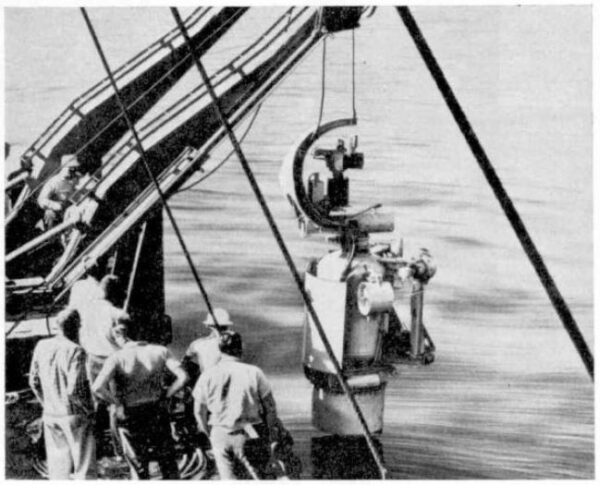
Developed for Shell Oil Company, MOBOT’s first job was to complete a well off the coast of Santa Barbara, California. Photo courtesy Meccano Magazine, February 1963.
In 1970, Shatto made industry history with the world’s first DP oil exploration riser-equipped drillship. “Since then, more than 4,000 DP systems have been built worldwide using Mr Shatto’s initial concepts,” noted Drilling Contractor magazine in 2018 after Shatto, chairman Emeritus of the Dynamic Positioning Committee of the Marine Technology Society, died on January 21.
“Known as the father of Dynamic Positioning, Howard Shatto’s contributions to the offshore oil and gas industry and the marine industry as a whole, go well beyond DP,” added the Dynamic Positioning Committee.
Making a MOBOT
When Hughes Aircraft Company built the first marine MOBOT for Shell Oil Company, the company adapted sonar and television cameras for navigation, propellers for propulsion, and an umbilical cable for control. With a mechanical arm, the offshore robot could turn bolts, operate valves and attach control hoses and guide lines.
“It was basically a swimming socket wrench,” reported a Shell engineer, describing the 14-foot, 7,000-pound underwater robot. Because of the necessity to pay traditional divers to rescue a clumsy, often entangled offshore robot, early models also became known as “a diver’s best friend.”
Shell Oil successfully used a MOBOT on a wildcat well in 250 feet of water off the coast of Santa Barbara, California, in October 1962. “It can swim, see, hear, and has a ‘nose’ that turn screws, work valves, and grip pipes and hoses,” noted the editor of Meccano Magazine in February 1963.
“It can also wield a wire brush and other tools,” added the editor.
Over the next 10 years, MOBOTs worked on 24 offshore wells – operating to depths of 1,000 feet for extended periods. The technology helped revolutionize the offshore industry worldwide.
Military Subsea Technology
During the Cold War, the U.S. Navy developed its own deep-sea technology for both submarine rescue and antisubmarine purposes. In 1963, the nuclear attack submarine USS Thresher sank with the loss of all hands 220 miles off the coast of Cape Cod, Mass.
The only vehicle capable of reaching a depth of 8,400 feet was the Navy’s manned bathyscaph Trieste, which found and photographed the wreckage. Unfortunately, Trieste had little capability to retrieve objects.
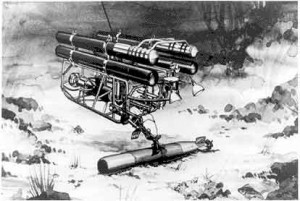
The Navy’s CURV I (Cable-Controlled Underwater Recovery Vehicle) recovers a lost nuclear bomb from the Mediterranean in 1966 near Palomares, Spain.
In January 1966 near the coast of Spain, a U.S. Air Force B-52 collided with its refueling tanker, scattering debris and four 70-kiloton hydrogen bombs over the Spanish coast. Three of the nuclear bombs were recovered on land, but the fourth was lost in the Mediterranean Sea.
With a combination of divers and the Woods Hole Oceanographic Institution’s manned submersible, Alvin, the missing atomic bomb was located at a depth of 2,850 feet. To retrieve it, the Navy employed its new CURV I (Cable-Controlled Underwater Recovery Vehicle), which snagged the bomb and pulled it to the surface.
Worldwide publicity briefly elevated the visibility of marine robotics, but the technology mostly remained submerged in military, scientific, and offshore oil and gas industry applications.
Secrets of the Titanic
In 1982, Robert Ballard of the Woods Hole Oceanographic Institute — and a former naval intelligence officer — approached the Navy as a possible source of funding to find the wreck of the Titanic.
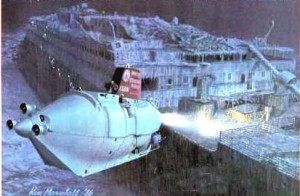
In 1986, Robert Ballard brought the manned submersible Alvin, above, to the wreck of the Titanic. He also utilized an ROV — a fiber optic “tethered eyeball.”
The Navy was more interested in developing Ballard’s fiber optic video system for deep sea surveys, and its potential to examine debris fields of two nuclear submarines USS Thresher (lost April 10, 1963) and USS Scorpion (lost May 22, 1968).
With Navy support, the oceanographer’s highly classified mission was presented to the public as only “a search for Titanic.” Ballard used the Argo, a towed undersea video camera sled, to survey and photograph both submarine wrecks, yielding invaluable data to his covert government sponsors.
Completing the secret mission’s objectives with 12 days to spare, Ballard’s team used Argo to find the Titanic on September 1, 1985, and received worldwide acclaim.
For 73 years Titanic had remained hidden at a depth of 12,460 feet. One year later, Ballard brought another Woods Hole veteran deep-diving manned submersible, Alvin, to the Titanic.
Then, for the first time, the public was able to see deeper into Titanic’s ghostly decks through the fiber optic eyes of the ROV Jason Jr. Later joined by another unmanned submersible, the Hercules, the two highly sophisticated ROVs brought undersea technology to prime-time television.
Offshore Production
While such “Eyeball Class” ROVs were well suited for marine archeology, observation and inspection, the demands of deep offshore oil production required development of heavy “Work Class” ROVs that could be equipped with a variety of tools.
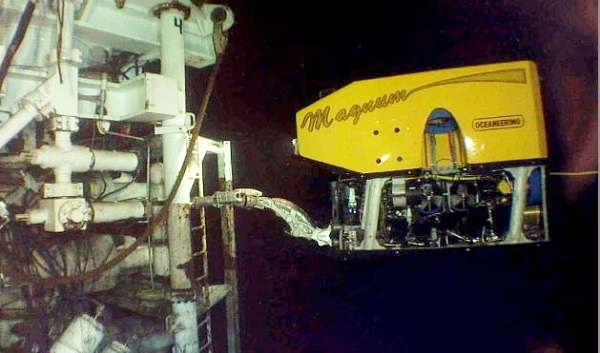
Remotely operated vehicles (ROVs) are most widely used by the offshore petroleum industry. New technologies allow access to great depths. Photo courtesy Oceaneering International.
Today, such an offshore robot can weigh ten thousand pounds, lift over one thousand, and operate at 10,000 foot depths. The petroleum industry is the principle user of this class of ROV. Further offshore exploration is prompting yet a new generation of marine robotics – the Autonomous Underwater Vehicle (AUV) which abandons the use of a physical cable connection to the mother ship.

Fiber optics link data signals between a 6,750-pound vehicle and the surface. Image courtesy Ocean Engineering.
Defined as “a crewless, non-tethered submersible which operates independent of direct human control,” AUVs make detailed maps of seabed topography and hazards that could impact proposed oil and natural gas offshore infrastructure.
Modern, survey class AUVs remain an emerging offshore technology — separated from Howard Hughes’ simple MOBOT by only 60 years.
Also see Petroleum Survey finds U-166.
_______________________
Recommended Reading: The Offshore Imperative: Shell Oil’s Search for Petroleum in Postwar America (2009); Diving & ROV: Commercial Diving offshore (2021); Offshore Pioneers: Brown & Root and the History of Offshore Oil and Gas
(1997); Breaking the Gas Ceiling: Women in the Offshore Oil and Gas Industry (2019). Your Amazon purchase benefits the American Oil & Gas Historical Society. As an Amazon Associate, AOGHS earns a commission from qualifying purchases.
_______________________
The American Oil & Gas Historical Society (AOGHS) preserves U.S. petroleum history. Become an AOGHS annual supporting member and help maintain this energy education website and expand historical research. For more information, contact bawells@aoghs.org. © 2024 Bruce A. Wells.
Citation Information – Article Title: “ROV – Swimming Socket Wrench.” Authors: B.A. Wells and K.L. Wells. Website Name: American Oil & Gas Historical Society. URL: https://aoghs.org/offshore-history/offshore-robot. Last Updated: January 12, 2024. Original Published Date: January 13, 2011.


